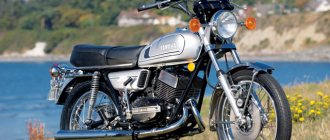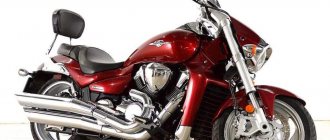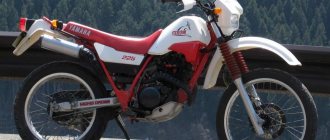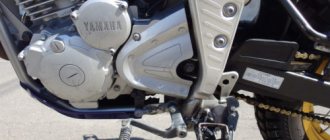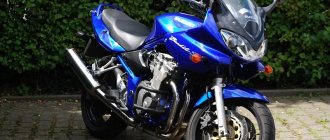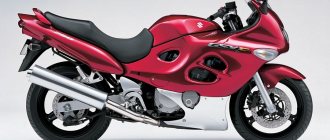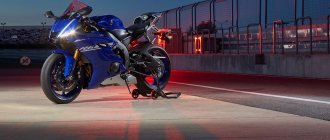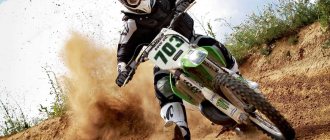, presented to the public in 1987, became a real find. This model turned out to be so successful that its production continued for 30 years , and according to the developers, “we are not going to remove it from the assembly line.” Initial plans included only the US and Japanese markets , but consumer interest from European countries forced the Japanese to reconsider their decision.
This Yamaha was delivered to Spain, from where it spread to other countries of the continent.
Yamaha TW 200 design
A motorcycle for Enduro and a cruiser rolled into one.
There are no special details in the motorcycle that aroused such consumer interest. The reason is hidden in the general concept . The model is not intended for track racing, but it can be used for light walks on difficult off-road terrain, as well as long trips.
In other words, dual sport - enduro + cruiser.
Side view.
Off-road conqueror.
On a white background.
The frame is made of steel, traditionally for models of this level, high-precision casting, which allows welding points to be reduced to a minimum. This principle made it possible to lighten the model while maintaining rigidity. Other features include good driving performance and minimal gas consumption, comparable to a scooter.
Suspension
At the front there is a fork, at the rear there is a monoshock absorber on the pendulum.
- The front suspension is made on the basis of a telescopic fork, the working stroke of which is 150 mm .
- At the rear there is a standard for the brand, a monoshock absorber on the pendulum. Its reserve is 160 mm .
There are no adjustment options, which allowed us to save a little on the final cost.
Generations
The model performed very well, so there were no deep changes.
The model turned out to be so successful that during the entire assembly it underwent only one minor change.
In the starting system, the starter leg was replaced with a conventional push-button version. Nevertheless, according to the factory documentation, the version with the button is the second generation, and the one with the leg is the first.
General information and design
The Yamaha 200AETX features a simplified two-stroke layout that is known for its ease of maintenance. This is not surprising, given the fact that high technical equipment did not in any way affect maintainability. The unit is equipped with advanced electronic systems, which are controlled by a built-in microprocessor in real time. Thus, there is no doubt about the stable operation of the Yamaha 200AETX electronics. In addition, most of these systems operate automatically, making driving more enjoyable and comfortable.
Main features of the motor:
- Two-stroke V-six cylinder layout
- High performance in any rpm range
- Capacitor type ignition
- Carburetor type fuel system
- Effective lubrication system Oil Injection System, which itself determines the dosage of oil, while relying on the degree of engine load
- Technology for effectively removing combustion products from the cylinders, as well as more rational use of the fuel mixture, which improves efficiency
- Plasma welding technology used in the production of cylinders. This has a beneficial effect on cooling and also reduces friction of parts
- Built-in microcomputer ensuring stable operation of all systems
- Remote control
- Digital e-launch Prime Start
- Built-in temperature and pressure monitoring devices in the motor. They notify the driver of possible problems. Thanks to this, you can solve the problem in advance to avoid more serious defects later.
- Fine-tuning the propeller had a beneficial effect on increasing maneuverability
- Galvanization of the most vulnerable engine parts, which, moreover, have an aluminum coating
- Supported boat transom height – up to 642 mm
- Shallow water safety feature
- The alternator capacity is 12V and 35A
- Supports connection of various Yamaha network devices. They are a convenient and informative navigator that allows the owner to always be aware of the status of all systems and operating modes.
Exterior
Despite the fact that the model is not a racing model, the first glance at it evokes just such associations. External body kit is reduced to the required minimum.
Minimum body kit, asceticism and strict lines.
Ascetic, strict, but at the same time very elegant. It’s interesting that if you look closely, you’ll notice that the bottom of the engine is covered with a protective plate. True, in pursuit of lightness and ventilation, the developers have provided so many holes in it that the possibility of protection remains a big question .
Front end
Despite the SUV class, the front wing, as conceived by the developers, should move with the tire, maximally protecting the pilot from dirt.
The model became the basis for many custom developments.
The main working part for shock absorption is located above it. There is no body kit as such at the front ; there is empty space between the tire and the head optics unit.
- A large square headlight (the first versions with a round headlight) with a minimal amount of plastic around is responsible for illuminating the road There is no separate division into low/high beam.
- The turn signals are mounted to the sides on separate legs.
- The front is colored glass , the back is opaque black plastic.
- An interesting design idea was the installation of reflectors (reflectors) on the sides of the block . They are located in its lower part, directed in different directions.
- A windshield is not provided in principle, but in many cases it is not necessary.
- The gas tank, with a capacity of 7 liters , fits so organically into the outline of the frame that it is practically invisible. The main protruding part is the neck cover.
Dashboard
When developing this part, the engineers followed the path typical for enduro versions.
Minimum options.
Analog speedometer, tachometer, and other control indicators - light bulbs that cluster on the left side. It is installed quite compactly, you can catch all the indicators at one glance.
All buttons and switches are located in a standard way, falling right under your fingers. The steering wheel is high and horned , but it is comfortable to drive even for a person who is not very tall. The mirrors are round and have limited adjustment options, but are initially positioned above the steering grips, making it possible to read the road situation without any problems.
Rear end
There is no rear wing; its role is played by the lower part of the frame.
- The mudguard is short , and above it, slightly protruding, are the stop and parking signals. The turn indicators are made in the same style as the front ones.
- Just like the front, three reflectors - two on the sides, one below.
- The saddle does not have a step , it is made in one block, repeating the bend of the frame. The possibility of seating a rear passenger is provided, but there may not be enough space for him.
- The design of the motorcycle allows for a choice - either traveling together or installing a rear case . The space for it is minimal. Given that the seat rack is small (the design of the saddle), going on long journeys on a motorcycle can be difficult.
Power point
A simple and economical engine, what else do you need for Enduro when you are far from civilization. A symbol of reliability!
One of the features that ensured great demand for the model was its simple, but at the same time very economical engine . Its characteristics turned out to be so successful that the initially planned replacement of the fuel supply system remained only in the drawings.
It was a 1-cylinder, 4-stroke engine that produced:
- working volume - 197 cm3;
- power - 15 hp;
- number of valves - 2;
- cooling - air;
- fuel supply - carburetor;
- ignition - electronic transistor;
- start - kick starter leg (until 2000), electric starter (since 2001);
- Tank volume - 7 l (6 + 1 reserve).
Since 2001, they began to install a different carburetor, but this did not change the main characteristics, fuel consumption decreased slightly.
Unlike other versions of the brand, here the engineers decided to use third-party development. Carburetors were supplied by the Japanese company Teikei .
Transmission and clutch
The motorcycle was equipped with a 5-speed gearbox. The switching pattern was standard.
Many bikers note the clarity of gearbox shifts.
Users noted the extraordinary smoothness and clarity of switching . True, there were cases when, instead of neutral, some other, not necessarily second, gear was engaged. “He sometimes switches gears according to a pattern that defies ordinary human logic. Roulette with one cartridge."
- Drive by chain.
- The clutch, according to the design typical for all Yamaha models, is multi-disc, oil bath .
Brakes
One of the details that did not characterize the bike from the best side were the brakes. Until 2001, drum versions were installed on both axles .
Until 2001 there were only drums here. With them the motorcycle braked very mediocrely.
When the generation changed, the front received disc:
- number of disks – 1;
- diameter – 220 mm;
- support – 2-piston,
The rear ones remained unchanged.
Front disc brakes with a diameter of 220 mm.
Enduro motorcycle chassis
The lightweight half-duplex frame uses the engine as a load-bearing element. This reduces the weight of the enduro motorcycle by eliminating the part of the frame that supports the engine, and simplifies the design of the motorcycle. The steering column holds the fork at a 25.8-degree angle and the trail is 86 millimeters. To a knowledgeable person, these numbers will tell you that the Yamaha TW200 is a nimble and responsive device when steering.
The 33 mm fork has a stroke of 16 cm. It has corrugated covers that protect the moving open parts of the fork from dirt that destroys the seals. A motor shock absorber with an external spring suspends the rectangular pendulum, giving the rear wheel 15 cm of travel. Although the suspension travel cannot be compared with pure off-road bikes, the suspension is soft and quite adequate for a universal motorcycle.
The TW200's braking system consists of a 110mm cable-actuated drum brake at the rear wheel and a hydraulic caliper on a 220mm disc at the front. The disc size is quite sufficient, but it lacks a contoured edge to improve self-cleaning, so there is some work to be done here. The wheels are spoked, well suited for off-road driving, and thick all-purpose tires measuring 130/80-18 at the front and 180/80-14 at the rear, due to their softness, partly complement the suspension.
Yamaha tw 200 2019 engine
Driving performance
According to the developers, the main application for the model was supposed to be fast and not very fast trips over rough terrain with many medium-sized obstacles, so the specification does not have any special racing characteristics.
Maximum speed
- Maximum speed - 120 km/h .
According to users, you can squeeze out more. The power reserve is small, but squeezing it so that the arrow lies is enough.
Fuel consumption
Claimed fuel consumption is 3.0 . Before 2000 it was 3.5 .
When driving in a mixed cycle, focus on fuel consumption of 4 liters per hundred
In a mixed cycle, the figure can approach the 4 liter mark, but still remains a clear record among representatives of the class.
Acceleration to hundreds
- Acceleration, as for a tourist, is considered normal - up to 9 seconds .
Yamaha TW200 motorcycle review (Trailway, TW200E)
The motorcycle is light, but due to the high center of gravity, when moving at low speeds, the lightness is not perceived. I was very pleased with the presence of an electric starter. The engine starts up instantly and runs quietly, so you can’t immediately tell whether it’s stalled or not. The seat is hard, but comfortable in that it does not interfere when riding while standing on the footrests. In general, the ergonomics of the seating position are well thought out, even the footrests are located low and the legs do not get tired at all when riding. The steering wheel is wide with a huge turning angle, this makes the motorcycle very maneuverable. All control of the buttons on the steering wheel is also perfect, your fingers find them themselves. The dashboard is typical Endurovsky, speedometer and indicator lights. But all this wealth is always in sight. I was pleased with the trunk; one day when I was getting ready to go fishing, I loaded it with both an inflatable boat and a tent.
The suspensions, with their modest travel, 160mm fork, 150mm swingarm, are very energy-intensive. Although the lion's share of bumps is absorbed by high-profile tires. The rubber is very wide and soft, this makes it possible to lay the motorcycle quite deeply on the asphalt. But the rubber demonstrates all its qualities on a sandy beach: where other motorcycles get buried, the Yamaha TW200 rides easily and does not sink into the sand. But the main element of Yamaha is narrow country roads and forest paths. Thanks to the grippy rubber, low weight and wide steering wheel, it can easily get out of any windfall and mud.
There is protection against dirt as such, but it only works for the driver, while the passenger faces the risk of getting all dirty. The front disc brake is 220mm, quite consistent with the capabilities of the device. The rear drum is a bit dull. The lighting technology is excellent: the headlight shines brightly and covers a large sector of the road, the speedometer illumination does not hurt the eyes. The blinking of the turn signals is noticeable even in bright midday sun.
I would like to share my driving impressions: the engine is very elastic, with good traction at the bottom, and has an even character without dips or catches. The Yamaha TW 200 is quite enough for driving along country roads. It seemed like the engine was deliberately strangled on the exhaust side. Yes, the engine is rather weak for the city, since the reserve in traction and revolutions disappears after 70 km/h. The gearbox never ceases to please, gears are engaged clearly and easily, neutral is caught instantly. This is most likely due to the soft clutch. A low first gear is what is needed for this motorcycle.
After a run of 10,000 km, the starter ordered it to be immediately disassembled; it began to make a grinding noise during operation. Having disassembled it, and not finding anything criminal, except for play in the front bearings. I corrected this shortcoming in a very simple way, placing a washer of suitable thickness under the bearing, and the starter never gave rise to any complaints.
In two seasons I have driven more than 15,000 km, mostly on country roads. The fact remains that nothing broke in the Yamaha, nothing leaked anywhere, not a single cable broke. I usually fed the Yamaha TW200 with 95 gasoline, but I often used 92 gasoline, and its engine digested it without problems. Fuel consumption was about 4 liters per hundred kilometers. And the pleasure of riding a motorcycle is worth a million. The price is certainly high and completely unrealistic for the residents of many of our villages. But for all kinds of hunting grounds and country clubs, as well as for wealthy citizens who like to live outside the city, the price is quite realistic.
Here are my subjective opinions.
1. Weak motor. Although those that recommend have 2-4 more horses, I don’t think the difference will be really noticeable.
The engine is low-speed and high-torque. It just so happened that it was either a high-speed, dashing car, but with a short resource, or less speed, less agility, but more endurance. I’m quite happy with the engine - I haven’t yet met a single ass from which TVha couldn’t take me out) But sometimes on the highway it seems that there’s not enough dynamics (I accelerated to a maximum of 120).
2. Very high cost of tires + inability to get them, especially mud ones. And they say that it is good only in deep sand and swamps, and in other cases it loses because of its width.
I tried it in the city and outside the city. I haven't tried quad tires yet. Handling in the city is not as sharp as on narrow tires, but I have no complaints - it’s quite pleasant to roll. In the city + wide tires - the tram rails have never knocked me over) Outside the city - my native element. I won’t say that it’s impossible to get rubber or that it’s incredibly expensive. It’s easy to plan the purchase of tires - when the tire wear is already about 50%, it’s time to order a new one and wait, riding, while spare parts arrive to you for replacement. While I’m riding a Dunlop on dirt and asphalt, only if I get into desperate mud do I have to help the motorcycle get out.
3. Not enough fan. That is, a motorcycle for enduro riding in the old-fashioned style and for the age category 35+.
Fan is subjective. I just wish there was a little more suspension travel - sometimes it's not enough. And so - you can ride at the cross-country training ground and in any direction and for any purpose. Confident and calm.
I’m 27 - I don’t think I’m retired yet) There’s gunpowder in the flasks 
For desperate events, you need to take something with a hard enduro orientation, and not a multi-purpose vehicle like a TV gun.
Maintenance - if you change consumables in a timely manner and “listen” to your spendthrift - will last for years.
In short, I personally am 85% satisfied with TVha. The remaining 15% is what it is not designed for. (Hard jumps or vice versa races on the tracks)
I took my motorbike in winter. I wanted to gain experience with cb400 in a couple of seasons, but after sitting out on them, I accidentally saw TW on choppers in showrooms. I sat down and immediately liked the fit and lightness. In general, just like mine. The ride so far this season is not great, but I will say that with each trip I like the motorcycle more and more. Mot Not fast. Yes, I didn’t accelerate it more than 110 - it’s no longer comfortable for me to drive. Cruising 80-90 highway, 60-70 city. The transmissions are short. The tank is not large - the bike drove 150 km and asked to switch to reserve. I searched the forum - it seems I’m not the only one with such indicators. I like the look in stock - but of course not as brutal as sports, choppers. On the ground - a fairy tale. I didn’t get into shit. I drive in the city, at the dacha. I appreciated the presence of a kickstarter in addition to the button. The battery runs out - no problem - it starts and goes. Friends are trying - like they say Voskhod bought what an 18 hp engine. etc. So, if you are dependent on someone else’s opinion, it’s better not to take it, or take it tuned for a cafe racer =) But I repeat, I like the bike – I definitely won’t sell it yet. And yes – I’m almost 35 =)))
I bought this motorcycle new at the PANAVTO showroom in May 2006. The mileage is currently 6,000 kilometers. This is not much, but some conclusions can already be drawn.
1. ASPHALT - the motorcycle is intended ONLY for dirt roads, mud, sand and other non-hard surfaces. On the asphalt it confidently holds 110-120 - this is its maximum speed, but you need to be afraid of transverse unevenness and bumps, at such a speed, after flying such a thing, a specific shimmy begins, and adrenaline is released from your pants. There is no emergency braking from normal speed... the weak front brake and drum brake at the rear make itself felt. I'll install a reinforced hose, maybe it will help. It's not very convenient to climb in traffic jams - the steering wheel is wide.
2. OFF-ROAD is his strong point!!! With these super tires I am not afraid to climb wherever the asphalt ends - this is the king of crappy roads. You can safely ride along the beach on the water, and most importantly, on the sand. The forest assault of any tree-sticks is painless, although the suspension is stiff, the wheels compensate for this. Dirt - oh how nice it is to skid while holding the front brake!!! Streams of water and mud bubble up from under the powerful TW tread... and then you just release the brake and easily get out of any deep puddle.
3. FALL - due to my carelessness, at a speed of about 60 km/h, I flew into a deep ditch. The result - after a short flight, the motorcycle turned over in the air, fell vertically on the handlebars and headlights, then, jumping, fell on my back (it’s clear that it was so soft for him!!!). Damage - the speedometer housing burst and partially fell apart (glued together), the instrument panel was scratched (in principle, it did not break, the headlight remained intact!!!!), the brake system was depressurized (cured by replacing the brake pads), minor scratches on the turn signals. Now imagine what would happen with another motorcycle...Super impact resistance!
4. GENERAL IMPRESSION –
PROS - economical (measurements in the combined cycle showed a consumption of 3.5 l/100 km), a small but durable motorcycle - it is unrealistic to overheat, optics - five points, capable of speeding through potholes, there is enough power even for two people, despite 15 hp. With. ALL-TERRAIN VEHICLE.
MINUSES - no chain, for 6000 I almost killed it, provided very regular lubrication... (if I were the designers, I would put a thicker chain in there, but where do they have dirt in Japan??!!), small tank - three liters more I wish... The rear steps broke off (they were poorly welded at the factory) - they were scalded all over. Super expensive tires (rear tube - 3000, cylinder - 8000 rubles, what do you think?).
Yes...and don’t even think about jumping on it...it could end badly. Overall, I give it a solid B.
I took a YAMAHA TW200 (Japanese version). I really liked that the rear suspension (pendulum) has grease fittings; after injection, the creaking that was there initially disappeared. I had to change the air filter because... The old one started to crumble a little.
Now about the pros and cons:
The landing on the TW is not very comfortable. I think it will be very uncomfortable for people taller than 185cm. After a long trip along the highway of about 60 km, my butt starts to hurt. Ergonomics are excellent; in sunny weather the indicators (neutral, turn signals and high beam) are practically invisible. At speeds after 80 km/h, the image in the mirrors becomes blurry due to vibration.
The engine is quite playful for its size. The first gear is short and thus has tractor traction. The gearbox is clear, but the clutch starts to grab only at the end (you get used to it quickly). The adjustment did not give anything, because... If you loosen the cable a little, the clutch begins to “drive” and the gears are engaged with a tight crunch. With a passenger, the engine does not pull as readily as if you are driving alone. Yes, the maximum speed of the TW200 is about 120 km/h, acceleration to hundreds is quite brisk, and then it starts to sour. But at all speeds the motorcycle feels quite confident and stable.
The suspension on the motorcycle is not exactly enduristic. The front one is short-stroke and quite rigid, but it was only possible to “break through” once, and then only with a passenger on the roads. The rear one also doesn’t have a lot of travel and it wouldn’t hurt at all to have an adjustable spring preload, because with a passenger the shock absorber often breaks. But if you ride a motorcycle alone, I have no complaints about the suspension. Yes, the rear shock absorber is not dismountable, and a new one is quite expensive
The brakes...the front one is quite tenacious, but at a speed of about 90 km/h it does not brake very readily; installing a reinforced brake hose partially solved the problem. The rear one is not entirely informative, one might say it’s flimsy, probably because it’s drum-like. I was pleased with the position of the link running above the pendulum from the brake pedal to the drum - it is impossible to bend or tear it off-road on some stump or root.
Operation in the city:
In the city, due to good ground clearance and crankcase protection, you can safely storm curbs, stairs, etc., but in a traffic jam, the wide steering wheel does not always allow you to squeeze between cars, and in my case, the installed hand protection added a little more dimensions. When starting at traffic lights, the motorcycle easily breaks away from the general forward flow, but of course you have to turn the engine. Fuel consumption is about 3.5 liters per hundred. The only pity is that the tank holds 7 liters of gasoline.
Off-road:
The motorcycle feels good when riding in the forest, across fields, gravel and other crap, the main thing, as they say, is without fanaticism and not getting carried away with speed. But the TW rides best on sand; with its wide wheels it guarantees good stability and maneuverability (tested in a sand quarry).
Overall I am very pleased with the motorcycle. And I’m not going to change it for another... there’s still something special about it!
Dimensions
Since the model was not positioned as a purely Japanese model, a person of both small and medium height can feel comfortable behind the wheel. The thoughtful placement of footrests and controls should not create problems for a tall motorcyclist.
Owners note a comfortable fit for a person of small and medium height.
At the same time, the lightness of the model and the large steering angle will allow you to maneuver normally in any situation.
Weight
Curb weight - 126 kg.
196 kg is a lot for Enduro..
The bikes supplied to the US markets were heavier . All American models received chrome trim to the maximum. But at the same time, the overall dimensions changed only once, with the change of generation.
The first data is before 2000, the second is after. The first and second generations, respectively.
- in length - 2091, 2061 mm;
- width - 822, 832 mm;
- height - 1121, 1106 mm;
- saddle height - 792 mm for both generations.
Wheelbase - 1251, 1322 mm .
Modifications
The generation change was the only official modification of the model.
Yamaha TW 225 is a rare guest in both foreign and domestic markets
In 2002, a limited number of bikes were produced on its basis, smaller in size, but with a more powerful engine. The modification did not receive an external name, but by analogy with the base model it was dubbed Yamaha TW 225 . The model did not appear in foreign markets; it was also difficult to find in domestic markets.
Brief history of the model
1987 - start of production and sales. Model: Yamaha TW200; Yamaha TW200T (Trailway) (Japan; North America). Factory designation: 2JL0.
1988 - no significant changes. Model: Yamaha TW200U (Trailway) (North America).
1989 - start of production and sales in Europe. Model: Yamaha TW200W (Trailway); Yamaha TW200E (North America; Europe). Factory designation: 3LY1, 3AW4.
1990 - no significant changes. Model: Yamaha TW200A (Trailway); Yamaha TW200E (North America; Europe). Factory designation: 3AW7.
1991 - no significant changes. Model: Yamaha TW200; Yamaha TW200B (Trailway); Yamaha TW200E (Japan; North America; Europe). Factory designation: 4CS1; 3AWA.
1992 - no significant changes. Model: Yamaha TW200D (Trailway); Yamaha TW200E (North America; Europe). Factory designation: 4CS1; 3AWD.
1993 - no significant changes. Model: Yamaha TW200; Yamaha TW200E (Trailway) (Japan; North America). Factory designation: 4CS2.
1994 - no significant changes. Model: Yamaha TW200E (Europe). Factory designation: 3LY2, 3AWK.
1995 - no significant changes. Model: Yamaha TW200G (Trailway); Yamaha TW200E (North America; Europe). Factory designation: 3AWN.
1996 - no significant changes. Model: Yamaha TW200; Yamaha TW200H (Trailway); Yamaha TW200E (Japan; North America; Europe). Factory designation: 4CS3; 3AWS.
1997 - no significant changes. Model: Yamaha TW200J (Trailway); Yamaha TW200E (North America; Europe). Factory designation: 3AWV.
1998 - the scrambler version of the TW200E appears on the domestic Japanese market. Model: Yamaha TW200 + TW200E; Yamaha TW200K (Trailway); Yamaha TW200E (Japan; North America; Europe). Factory designation: 4CS5 + 4CS4; 3AWY.
1999 - The regular version of the TW200 is no longer offered in the Japanese market. Model: Yamaha TW200E; Yamaha TW200L (Trailway); Yamaha TW200E (Japan; North America; Europe). Factory designation: 4CS6; 5FY4.
2000 - the domestic Japanese scrambler version of the TW200E receives a front disc brake and minor changes associated with stricter environmental standards (the curb weight increased by 2 kg). Model: Yamaha TW200E; Yamaha TW200M (Trailway); Yamaha TW200E (Japan; North America; Europe). Factory designation: 5LB1; 5FY7.
2001 is the last year of production of the domestic Japanese TW200E. Export versions receive a front disc brake. The Trailway prefix in the name of the American versions was removed. Model: Yamaha TW200E; Yamaha TW200N; Yamaha TW200E (Japan; North America; Europe). Factory designation: 5LB2; 5FYA.
2002 - no significant changes. Model: Yamaha TW200P; Yamaha TW200E (North America; Europe). Factory designation: 5FYE.
2003 - no significant changes. Model: Yamaha TW200R; Yamaha TW200E (North America; Europe). Factory designation: 5FYJ.
2004 - no significant changes. Model: Yamaha TW200S; Yamaha TW200E (North America; Europe). Factory designation: 5FYN.
2005 - no significant changes. Model: Yamaha TW200T1; Yamaha TW200E (North America; Europe). Factory designation: 5FYT.
2006 - no significant changes. Model: Yamaha TW200V; Yamaha TW200E (North America; Europe). Factory designation: 5FYX.
2007 - no significant changes. Model: Yamaha TW200W1; Yamaha TW200E (North America; Europe). Factory designation: 10D3.
2008 - no significant changes. Model: Yamaha TW200X; Yamaha TW200E (North America; Europe). Factory designation: 10D7.
2009 - no significant changes. Model: Yamaha TW200Y; Yamaha TW200E (North America; Europe). Factory designation: 10D8.
2010 - no significant changes. Model: Yamaha TW200Z; Yamaha TW200E (North America; Europe). Factory designation: 10DF.
2011 - no significant changes. Model: Yamaha TW200A1; Yamaha TW200E (North America; Europe). Factory designation: 10DK.
2012 - no significant changes. Model: Yamaha TW200B1; Yamaha TW200E (North America; Europe). Factory designation: 10DP.
2013 is the last year of production of European versions. Model: Yamaha TW200D1; Yamaha TW200E (North America; Europe). Factory designation: 10DU.
2014 - no significant changes. Model: Yamaha TW200E1 (USA); Yamaha TW200E (Canada). Factory designation: 10DX.
2015 - no significant changes. Model: Yamaha TW200F1 (USA); Yamaha TW200E (Canada). Factory designation: B753.
2016 - no significant changes. Model: Yamaha TW200G1 (USA); Yamaha TW200E (Canada). Factory designation: B756.
2017 - no significant changes. Model: Yamaha TW200H1 (USA); Yamaha TW200E (Canada). Factory designation: B759.
2018 - no significant changes. Model: Yamaha TW200 (USA); Yamaha TW200E (Canada). Factory designation: B75C.
2019 - no significant changes. Model: Yamaha TW200 (USA); Yamaha TW200E (Canada).
2020 - no significant changes. Model: Yamaha TW200 (USA); Yamaha TW200E (Canada).
2021 - no significant changes. Model: Yamaha TW200 (USA); Yamaha TW200E (Canada).
Flaws
The model has few disadvantages.
The main thing is considered to be limited space , but at the same time, when traveling together, the motorcycle loses dynamism and power reserves. A solo trip + an installed case allows you to travel long distances.
There is space for a trunk and back luggage.
- But also the disadvantages include lower first gear . If you start on the highway, it is better to start from second. But for the city and harsh off-road conditions, low gear is the right choice.
- Sometimes the starter has problems . During operation, the bearings become distorted, which causes unpleasant noises during startup and may lead to the need to replace the part. You can extend the life by placing washers of the required thickness.
and dignity
The pluses include the wide rear tire. Thanks to its increase, the motorcycle's cross-country ability has significantly increased.
The TW 200 feels good both on snow and on a sandy beach, on dirt and asphalt. Wide tires also help the bike corner when cornering .
Run-in
Yamaha recommends that you perform regular maintenance on your device and check its condition after each use. In addition, running in the engine is equally important. This procedure is performed only once, and preferably immediately before purchasing the product. The essence of running-in is to adapt engine parts to environmental conditions. This is especially true for the harsh Russian conditions. The adaptability of the engine to the peculiarities of the local climate will have a beneficial effect on reliability, which will make it possible not to resort to more frequent repairs, and in the best case, it will be possible to increase the time interval between maintenance. Thus, this will reduce the cost of owning the motor. However, in order to achieve the desired result from running in, you must comply with all the conditions for performing this procedure and properly prepare for it.
In preparation for the break-in, a large amount of fuel will be required, which should be enough for the entire 10 hours of break-in. In the case of the Yamaha 200AETX, the fuel is mixed automatically in a ratio of 50:1 (gasoline and oil respectively).
In addition, it is necessary to prepare the engine for refueling consumables. So, before this, the engine must be installed in a vertical position. Transmission fluid is poured into the gearbox using a 120 ml medical syringe. In addition, it must be borne in mind that the gear oil must comply with the TCW-3 standard, and also meet the viscosity and tolerance parameters specified in the instructions for the motor.
It is also equally important to check the operation of important systems before running in. Thus, liquid cooling is of particular vital importance. To avoid problems with overheating, you need to make sure that a pressurized stream of water comes out of this system. It should flow out like a fountain from a special hole.
Let's start running in
- Preparing the outboard motor to start moving. To do this, you need to warm it up at idle for an hour.
- In the second hour of operation, you can start driving, moving from idle to low speed. On the third hour of work - another increase to the middle zone. Such a gradual increase will lead to an increase in engine power to 80-90 percent. This will take approximately seven to eight hours
- Engine operation at 100% power is allowed for 20-25 minutes. Exceeding this norm will lead to problems in the cooling system.
- Another way to avoid overheating is to lower the engine speed for a short time. At the same time, in this way you can create a variable load, which is very useful for adapting parts
- Thus, during the entire break-in period we move at idle, low, medium and high speeds, until the procedure is completed
- At the end of the run-in, we turn off the engine, having previously judged it at idle. We drain the used fluids, and then fill in new oil and fuel. Run-in is complete.
